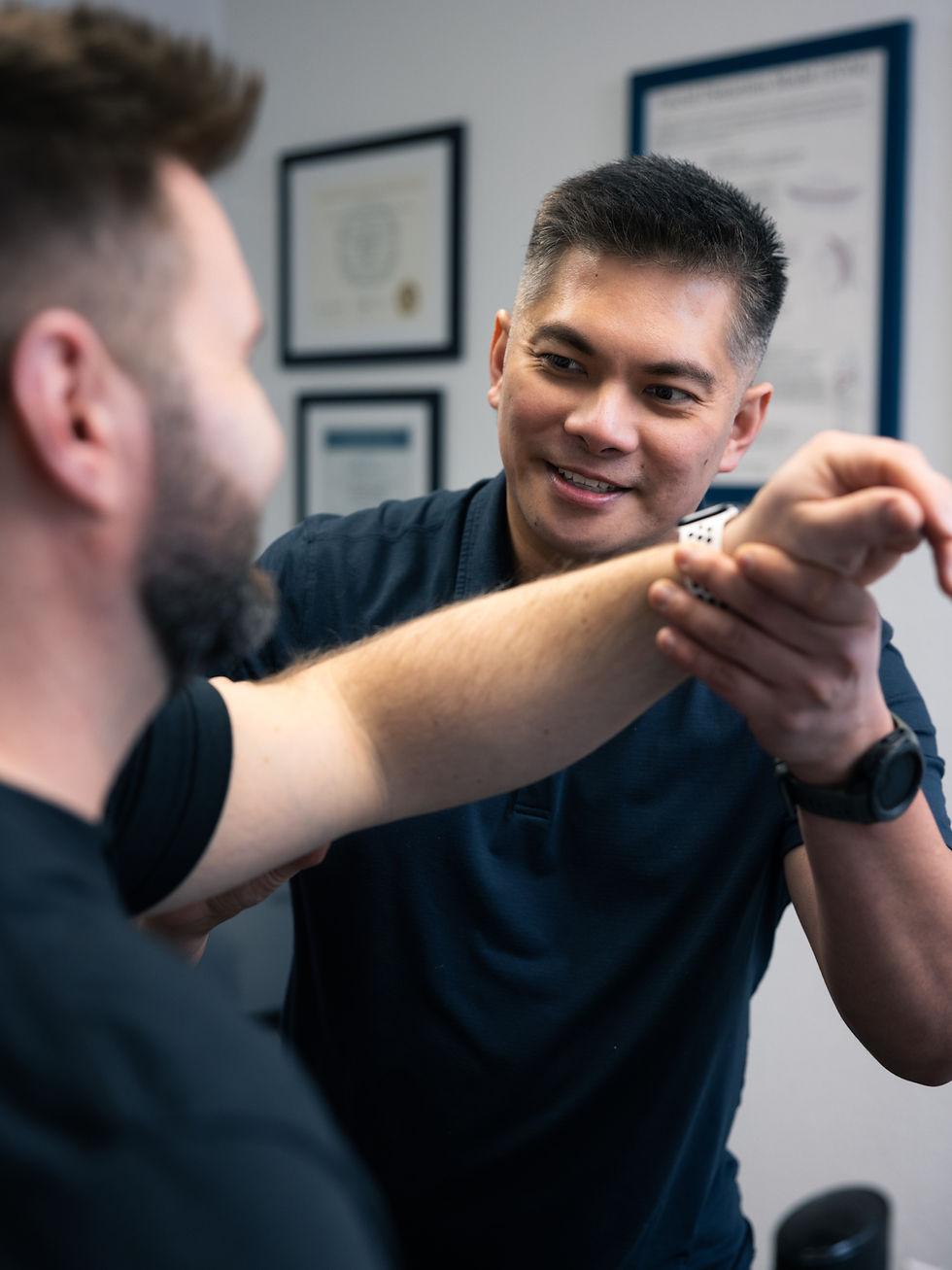Shoulder Health and Injury Prevention: A Guide for Lifelong Health
- Mark Jamantoc

- Feb 9
- 3 min read
Updated: Mar 23
Tags: #ShoulderHealth #InjuryPrevention #PhysicalTherapy #RotatorCuff #ScapularStabilization #Posture #StrengthTraining #Flexibility #Mobility #SportsInjury
The shoulder is one of the most versatile and mobile joints in the human body, allowing for a wide range of motion in daily activities and sports. However, this mobility also makes the shoulder susceptible to injuries, including rotator cuff tears, impingements, and tendonitis. Maintaining strong, flexible, and well-conditioned shoulders is crucial for preventing injury and ensuring long-term function. This blog post explores key strategies for shoulder health and injury prevention, particularly from a physical therapy perspective.

Understanding Shoulder Mechanics
The shoulder joint is a ball-and-socket joint that relies on a combination of muscles, tendons, and ligaments to function properly. The rotator cuff, a group of four muscles and their tendons, plays a vital role in stabilizing the shoulder. Without adequate stability and strength, the shoulder is at higher risk of dysfunction and injury.
For more detailed information on shoulder mechanics, visit:
Common Causes of Shoulder Injuries
Shoulder injuries often result from overuse, improper mechanics, or sudden trauma. Some of the most common causes include:
Poor posture: Rounded shoulders and forward head posture can place excessive stress on the shoulder joint.
Muscle imbalances: Weak rotator cuff muscles and overdeveloped chest muscles can lead to improper shoulder mechanics.
Repetitive overhead motions: Activities such as swimming, tennis, and weightlifting can cause wear and tear over time.
Lack of flexibility: Tight muscles in the chest and shoulders can limit mobility and increase strain on the joint.
Acute injuries: Falls, direct impacts, or sudden forceful movements can cause dislocations, fractures, or strains.
For more insights, check out:
Strategies for Shoulder Injury Prevention
To keep your shoulders healthy and resilient, consider incorporating the following strategies into your routine:
1. Strengthen the Rotator Cuff
Perform exercises such as external rotations, internal rotations, and resistance band pulls to build strength and stability in the rotator cuff muscles.

2. Maintain Proper Posture
Practice good posture by keeping your shoulders relaxed, pulling them slightly back, and avoiding prolonged forward head posture.
3. Improve Shoulder and Upper Back Flexibility
Incorporate stretches like doorway chest stretches, cross-body shoulder stretches, and thoracic mobility exercises to improve flexibility.
4. Balance Strength Training
Ensure that your strength training routine includes balanced development of the chest, back, and shoulder muscles to prevent imbalances.

5. Stabilize the Scapula
Scapular stabilization is crucial for overall shoulder function and injury prevention. Strengthen the muscles around the scapula by performing exercises such as scapular retractions, wall slides, and prone Y-T-W exercises. Proper scapular control ensures that the shoulder moves efficiently and reduces stress on the rotator cuff. For more information on this, consuslt with your physical therapist or rehab professional.

6. Modify Activities to Reduce Strain
Use proper lifting techniques, take breaks from repetitive motions, and avoid overloading the shoulder joint during workouts.
7. Seek Professional Guidance
If you experience persistent shoulder pain or discomfort, consult a physical therapist for an evaluation and personalized rehabilitation program.

Did you know? We specialize in shoulder injury and rehabilitation! schedule an appointment today if that nagging shoulder issue is not getting better. Schedule your appointment by clicking the SCHEDULE ONLINE TAB above.
Conclusion
By proactively strengthening, mobilizing, and protecting your shoulders, you can significantly reduce the risk of injury and maintain optimal function. Implementing these physical therapy-based strategies can help ensure that your shoulders stay healthy for years to come. Remember, prevention is key to maintaining long-term mobility and performance in daily activities and sports.
References
American Academy of Orthopaedic Surgeons (AAOS). https://www.aaos.org/
National Library of Medicine – Shoulder Anatomy. https://pubmed.ncbi.nlm.nih.gov/
National Institute of Arthritis and Musculoskeletal and Skin Diseases (NIAMS). https://www.niams.nih.gov/
American Physical Therapy Association (APTA). https://www.apta.org/
Mayo Clinic – Rotator Cuff Exercises. https://www.mayoclinic.org/
Physiopedia – Rotator Cuff Training. https://www.physio-pedia.com/
Harvard Health – Posture and Its Impact. https://www.health.harvard.edu/
National Academy of Sports Medicine (NASM) – Stretching Techniques. https://www.nasm.org/
National Strength and Conditioning Association (NSCA). https://www.nsca.com/
Find a PT – American Physical Therapy Association (APTA). https://www.choosept.com/





Comments